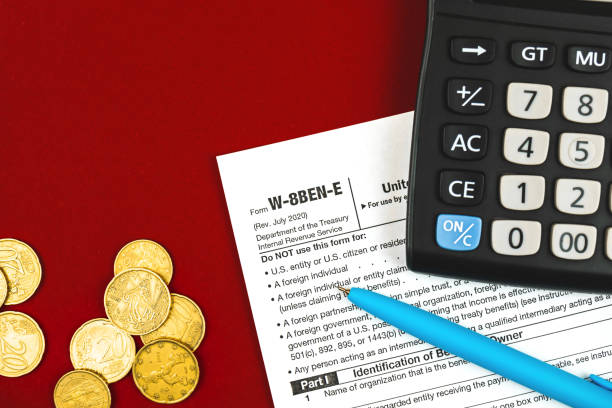Filling out a W-8 form can be a daunting task, especially for non-U.S. residents who are not familiar with the U.S. tax system. The W-8 form is an Internal Revenue Service (IRS) form used to certify a foreign person’s tax status and claim exemption from certain tax withholding requirements. The form is required by U.S. banks, brokerage firms, and other withholding agents when making payments to foreign individuals or entities.
Properly filling out a W-8 form is crucial to avoid unnecessary tax withholding, as well as to ensure compliance with U.S. tax laws. Inaccurate or incomplete information on the form can result in delayed or incorrect payments, which can be a hassle for both the withholding agent and the recipient.
This complete guide to filling out a W-8 form will provide a step-by-step process to help individuals understand the form’s purpose, identify which version of the form to use, and provide detailed instructions on how to properly complete each section. The guide will also address common questions and concerns that individuals may have when filling out the form, such as the definition of a foreign person, the types of income that may be exempt from withholding, and how to obtain a U.S. taxpayer identification number (TIN) if necessary.
Whether you are an individual who is receiving income from a U.S. source or a foreign entity doing business in the U.S., understanding how to properly fill out a W-8 form is essential for avoiding unnecessary tax withholding and ensuring compliance with U.S. tax laws. This guide will provide the necessary information to help individuals complete the form accurately and efficiently.
Understanding the Purpose of the W-8 Form
The W-8 form is a tax form used by foreign individuals and entities who receive income from US sources to establish their tax status and eligibility for reduced tax withholding. The form is issued by the Internal Revenue Service (IRS) and comes in several versions, including the W-8BEN, W-8ECI, W-8IMY, and W-8EXP, each of which is used for a different purpose.
The purpose of the W-8 form is to provide information to the IRS about the taxpayer’s status for US tax purposes. The form allows foreign taxpayers to claim a reduced rate of withholding tax on certain types of income received from US sources, such as interest, dividends, and royalties. The withholding tax is a tax that is withheld by the payer of the income and paid to the IRS on behalf of the taxpayer. The amount withheld depends on the type of income and the tax treaty between the US and the taxpayer’s home country.
The W-8 form requires the taxpayer to provide certain personal and tax-related information, such as their name, address, tax identification number, and tax status. The form also requires the taxpayer to certify under penalty of perjury that the information provided is accurate and complete. Additionally, the form may require the taxpayer to provide additional documentation, such as a certification of foreign status, to support their claim for reduced withholding tax.
The W-8 form is typically provided to the payer of the income, such as a US financial institution or other entity, who will use the information to determine the appropriate amount of withholding tax to apply to the payment. If the taxpayer fails to provide a W-8 form or the information provided on the form is incomplete or incorrect, the payer may be required to withhold tax at the maximum rate.
It is a tax form used by foreign individuals and entities to establish their tax status and eligibility for reduced tax withholding on certain types of income received from US sources. The purpose of the form is to provide the IRS and payers of US-source income with information necessary to comply with US tax laws and treaties.
Types of W-8 Forms
W-8 forms are a series of tax forms used by non-US citizens and foreign entities to declare their tax status and eligibility for exemption from US tax withholding on various types of income received from US sources. There are several different types of W-8 forms that are used depending on the individual or entity’s specific tax status, and each form has its own unique purpose and requirements. The following are the types of W-8 forms:
W-8BEN
This form is used by individuals who are not US citizens or residents and are claiming a reduced rate of withholding tax under a tax treaty. The form requires the individual to provide personal identifying information, such as their name, address, and taxpayer identification number, as well as information about their tax treaty eligibility.
W-8BEN-E
This form is used by foreign entities, such as corporations or partnerships, that are not US taxpayers and are claiming a reduced rate of withholding tax under a tax treaty. The form requires the entity to provide identifying information, such as its name and address, as well as information about its ownership and control structure.
W-8ECI
This form is used by non-US persons who have income that is effectively connected with a US trade or business. The form allows the individual to claim exemption from US withholding tax on this income.
W-8EXP
This form is used by foreign governments, international organizations, and other foreign entities that are claiming exemption from US tax withholding on income received from US sources. The form requires the entity to provide identifying information, as well as information about its tax status and treaty eligibility.
W-8IMY
This form is used by foreign intermediaries, such as banks or brokers, that are acting as a conduit for payments made to other foreign persons. The form requires the intermediary to provide identifying information about both itself and the ultimate recipient of the payment.
Each W-8 form serves a specific purpose and requires different information to be provided. It is important for non-US citizens and foreign entities to correctly fill out the appropriate W-8 form to ensure that they are properly reporting their tax status and avoiding unnecessary tax withholding on US-source income.
Related: What is Form W-7: Application for IRS Individual Taxpayer Identification Number
7 Steps to Fill Out a W-8 Form
Filling out an W-8 form can be a little confusing. Here’s how you’re supposed to do it, step by step.
Step 1: Identify the correct type of W-8 form
The first step in filling out a W-8 form is to identify the correct type of form that you need to fill out. This will depend on your individual circumstances, such as whether you are an individual or an entity and whether you are claiming tax treaty benefits or certifying your foreign status.
Step 2: Provide your personal information
The second step in filling out a W-8 form is to provide your personal information. This will include your name, address, and taxpayer identification number (TIN). If you do not have a TIN, you will need to provide an explanation for why you do not have one.
Step 3: Certify your foreign status
The third step in filling out a W-8 form is to certify your foreign status. This means that you are confirming that you are not a U.S. person and are therefore not subject to U.S. taxation on your worldwide income. You will need to provide your country of residence and your foreign tax identification number (if applicable).
Step 4: Claim tax treaty benefits (if applicable)
The fourth step in filling out a W-8 form is to claim tax treaty benefits if they apply to you. Tax treaty benefits may reduce or eliminate your tax liability in the United States. You will need to provide the applicable tax treaty article and a statement of the facts that allow you to claim the benefits.
Step 5: Provide your beneficial owner information
The fifth step in filling out a W-8 form is to provide your beneficial owner information. This means that you will need to provide information about the person or entity that ultimately owns or controls the income that is being paid to you. This may include their name and address, as well as their country of residence. If you are a foreign corporation or partnership, you will need to provide information about your shareholders or partners.
Step 5 (continued): Provide your beneficial owner information
In addition to providing the name of the beneficial owner, you will need to provide their address, country of residence, and TIN (if applicable). If the beneficial owner is an entity, you will also need to provide their type of entity (e.g. corporation, partnership, trust), the country in which they were organized or incorporated, and the name and TIN of the responsible party (the individual who controls, manages, or directs the entity).
Step 6: Provide your intermediary information (if applicable)
If you are an intermediary or a flow-through entity, you will need to provide your intermediary information in step 6. This includes your name, address, and TIN (if applicable). You will also need to provide the name, address, and TIN of any intermediary or flow-through entity through which the income is being paid to you.
Step 7: Sign and date the form
The final step in filling out a W-8 form is to sign and date the form. By signing the form, you are certifying that the information you have provided is accurate and complete to the best of your knowledge. If you are filling out the form on behalf of another person or entity, you will also need to provide your capacity to act on their behalf (e.g. power of attorney).
Tips for Filling Out a W-8 Form
Filling out a W-8 form can be a daunting task, especially if you are not familiar with the U.S. tax system. To help you navigate this process, we have compiled a list of tips to make filling out the W-8 form easier and less intimidating.
Tip #1: Determine your tax status
The first step in filling out the W-8 form is to determine your tax status. This will depend on your individual circumstances and the type of income you receive. There are four possible tax statuses: non-resident alien individual, foreign entity, foreign corporation, or foreign partnership.
To determine your tax status, you can refer to the IRS website or seek the advice of a tax professional.
Tip #2: Gather your information
Before you start filling out the W-8 form, make sure you have all the necessary information on hand. This includes your name, address, taxpayer identification number (TIN), and any other relevant information such as your country of citizenship or tax residency.
Tip #3: Understand the different parts of the form
The W-8 form is divided into several parts, each with its own purpose. Understanding what each section is asking for can help you complete the form accurately and efficiently.
Part I: Identification of Beneficial Owner
This section asks for basic information about the person or entity receiving the income. You will need to provide your name, address, country of citizenship, and TIN.
Part II: Claim of Tax Treaty Benefits
This section allows you to claim any tax treaty benefits that may apply to your situation. To claim a tax treaty benefit, you will need to provide the article number and specific provisions of the tax treaty that apply to you.
Part III: Certification
This section requires you to certify that the information you have provided is accurate and that you are the beneficial owner of the income.
Tip #4: Provide accurate and complete information
It is important to provide accurate and complete information on the W-8 form. This will ensure that the payer can correctly identify you and withhold the appropriate amount of tax on your income.
Tip #5: Submit the form on time
If you receive income from a U.S. source, you are required to submit the W-8 form before you receive any payments. Failing to submit the form on time may result in additional taxes or penalties.
Tip #6: Keep a copy of the form
It is always a good idea to keep a copy of the W-8 form for your records. This will be useful if you need to refer to the information later or if you are asked to provide proof of your tax status.
Filling out a W-8 form can be a complex process, but by following these tips, you can ensure that you provide accurate and complete information, claim any applicable tax treaty benefits, and submit the form on time. If you are unsure about any aspect of the form, it is always best to seek the advice of a tax professional to ensure that you comply with U.S. tax laws.
Conclusion
Filling out a W-8 form can be a complex process, but it is an important step in complying with U.S. tax laws. By following the steps outlined in this guide and paying close attention to the instructions, you can properly fill out the form and ensure that you are in compliance with U.S. tax laws. If you have any questions or concerns about filling out the form, it is always a good idea to seek professional advice.



